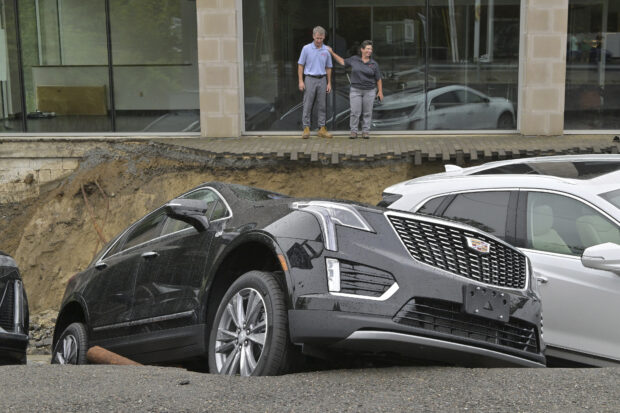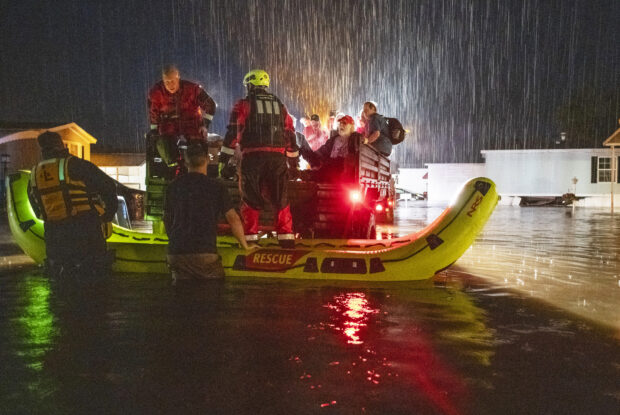Threats of tornadoes, more rain hitting soaked New England

Crews work on a section of Pleasant Street in Leominster, Mass., which was washed out Tuesday, Sept. 12, 2023, after heavy rain fall in the town overnight. (AP Photo/Josh Reynolds)
LEOMINSTER, Massachusetts — Threats of tornadoes and thunderstorms are expected to keep New England on edge Wednesday night, as residents in Massachusetts and Rhode Island spent much of the day cleaning up flood damage and bracing for the arrival of Hurricane Lee.
The National Weather Service said it’s looking into reports of strong winds that toppled trees and knocked down power lines in Rhode Island and Connecticut but is unable to say whether they were the result of tornadoes. A tornado warning was extended until 5:45 p.m. for several Massachusetts counties.
Rob Megnia, a meteorologist with the weather service, said they have received reports of about 20 trees down in Killingly, Connecticut, and trees and power lines down in Foster, Rhode Island.
“Typically, we would have to go out and do a survey to determine if it’s a tornado unless there’s visual confirmation, but we don’t have that yet,” Megnia said.
Emergency sirens could be heard late Wednesday afternoon in parts of Providence, Rhode Island, as cell phones pinged with a tornado warning. By early evening, the weather service said a severe thunderstorm capable of producing tornadoes was moving quickly east toward the Massachusetts border, from Cumberland, Rhode Island.

From left, car dealership owner Rick Durand Owner of Durand Cadillac and controller Michelle Bettez react beside three vehicles that fell into a sinkhole that was washed out of his car dealership Tuesday, Sept. 12, 2023, in Leominster, Mass. after more than 9 inches of rain fell overnight. (AP Photo/Josh Reynolds)
Late Tuesday, Massachusetts Gov. Maura Healey issued a state of emergency following the “catastrophic flash flooding and property damage” in two counties and other communities. The 10 inches (25 centimeters) of rain over six hours earlier in the week was a “200-year event,” said Matthew Belk, a meteorologist with the National Weather Service in Boston.
Healey said Wednesday that while there aren’t plans to call up the National Guard, the state’s emergency management agency is keeping a close eye on the weather and is prepared to offer assistance.
She said the state is monitoring the conditions of dams in many communities and urged residents to take seriously any warnings of potential flooding and to stay off the roads when ordered.
“Something that looks pretty minor can, just within a couple of hours, turn into something very serious, potentially deadly and very, very destructive,” Healey said.
The rain created several sinkholes in Leominster, Massachusetts, including one at a dealership where several cars were swallowed up. In Providence, Rhode Island, downpours flooded a parking lot and parts of a shopping mall. Firefighters used inflatable boats to rescue more than two dozen people stranded in cars.
Parking lots at several businesses briefly became lakes in Leominster and North Attleborough, and many front yards were still partially covered in water. For a second day, families were busy assessing the damage and removing flood-damaged debris. The sounds of generators filled the air in many neighborhoods, as residents worked to remove water from their basements.
John DeCicco, a retired school teacher in Leominster, said residents who started the day with dread and apprehension over a forecast for more rain were feeling more optimistic later in the day. He said residents of the close-knit community were helping each other clean up and opening their homes to others whose residences are uninhabitable.
“We’re going to get through this together,” said DeCicco, who loaned a pair of generators to neighbors during the flood to keep their water pumps going.
DeCicco said he lived through the Blizzard of 1978 that dumped 30 inches of snow and an ice storm in 2008, but he said the intensity of the electrical storm and torrents of rain were a shock.
“You can call out the snow plows to push the snow around but you can’t call the snow plows to push the water around,” he said.
Dawn Packer, who runs a North Attleborough home preschool, looked across the street Monday evening to see a UPS truck floating in several feet of water. Soon her yard was flooding.
“All of sudden, the door smashed open. The water was so forceful. It just smashed the door open and poured in, 4 feet,” she said. “The refrigerator just shot up into the air and fell down on its side. It was horrific.”

Firefighters use boats and a military truck to evacuate residents and pets as floodwaters rise in the Meadowbrook Acres neighborhood of Leominster, Mass., Monday, Sept. 11, 2023. (Rick Cinclair/Worcester Telegram & Gazette via AP)
After a dry day, it started raining in Leominster again on Wednesday afternoon. Parts of Massachusetts and Rhode Island were under a flash flood warning. Earlier in the day, there were heavy downpours in Danbury, Connecticut, where officials said they had to rescue several people from vehicles stuck in floodwaters.
Rain from Hurricane Lee didn’t contribute to the flooding earlier this week. But it could inundate parts of the coastal Northeast during the weekend, forecasters said. Lee is traveling north and could make landfall in Nova Scotia, Canada, possibly as a tropical storm, forecasters said.
“The ground is saturated. It can’t take in anymore,” Dean Mazzarella, mayor in Leominster, said at a news conference Wednesday in the city about 40 miles (65 kilometers) northwest of Boston. But he said the city had emergency resources at the ready “for whatever the weather brings.”
Mazarella said up to 300 people were evacuated by Tuesday morning in the city, which has not seen such widespread damage since a 1936 hurricane. Most buildings downtown flooded and some collapsed. Rail service also was disrupted.
Mazzarella said the city was trying to help get assistance to homeowners and businesses that suffered damage. He said early estimates on city infrastructure restoration projects could be anywhere from $25 million to $40 million.
Leominster’s director of emergency management, Arthur Elbthal, said two dams out of 24 in the city sustained damage. They held, and the city is reinforcing them.
New England has experienced its share of flooding this summer, including a storm that dumped up to two months of rain in two days in Vermont in July, resulting in two deaths. Scientists are finding that storms around the world are forming in a warmer atmosphere, making extreme rainfall a more frequent reality now. A warming world will only make that worse.